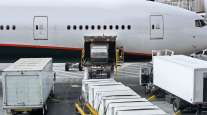Truckload Firms Link Rate Gains to Tightened Capacity
This story appears in the Sept. 20 print edition of Transport Topics.
NEW YORK — Many carriers, particularly in the truckload sector, said they are winning rate increases from shippers that typically are at least 5%, reflecting the industry’s tight capacity.
As truckload fleets report rate increases, third-party logistics firms such as Transplace Inc. are trying to minimize them, and less-than-truckload carriers want more price increases, executives said at Dahlman Rose’s investor conference here Sept. 8-9.
“Shippers wouldn’t be giving 7% to 10% increases if they thought they could get someone to cover their freight [for less],” said Paul Will, chief financial officer at truckload carrier Celadon Group Inc.
“We are able to lead the pricing discussion with our customers,” said David Jackson, chief financial officer at Knight Transportation, another truckload fleet after seeing rates fall 7% and 10% since the recession began.
“In the end, [shippers] haven’t given back all that they took,” he said, noting that Knight is particularly focused on boosting profits on 30% of its freight that has the lowest margins.
“They are at risk of not getting capacity,” he said, referring to shippers in that lowest margin group.
Third-party logistics companies acknowledged the price pressure.
“The challenge we have with our customer base is setting their expectations that rates are going up, not down,” said Robert Bianco Jr., president of Con-way Inc.’s Menlo Logistics unit. “The pendulum has swung in favor of asset-based trucking companies. Our challenge is to be the middleman and limit those” increases.
“We have been moderately successful in holding off the increases,” said Matthew Menner, a senior vice president at Transplace Inc., Frisco, Texas. “We had to push the eject button for carriers that were pushing yield.”
Dana Burleigh, senior supply chain manager for Schneider Logistics, said, “We took advantage of double-digit decreases. Our goal is to try to mitigate the increases. Some carriers are asking up to 5% across the board.”
Schneider Logistics’ parent company is truckload carrier Schneider National Inc., which declined to comment on the carrier’s rates.
Other sources confirmed the rising rate pattern.
Transport Capital Partners’ August carrier survey showed 63% reported rate increases of 5% or more.
Jason Seidl, a Dahlman Rose analyst, said a major less-than-truckload carrier has notified customers it plans to raise rates by about 5%.
“Now that someone has [raised rates], there is a higher likelihood others will follow suit,” Seidl said. “There is a better chance this increase will stick in this current period because there is a lack of capacity in LTL.”
Seidl said such increases apply to 20% to 30% of freight and occur two or three months later in the year.
Some LTL executives welcomed the change without saying whether they also would boost prices.
“The industry needs price increases,” suggested Richard O’Dell, chief executive officer of Saia Inc., Duluth, Ga.
“Anytime someone takes a general rate increase out of cycle, that should be a positive.”
“There is an opportunity to move price,” said Richard Gaetz, CEO of Vitran Corp., Toronto, which raised rates 4% this year. “We are hearing a lot of good chatter in the marketplace. It’s a good opportunity for the LTL industry to catch up with the pricing initiatives of the truckload, rail and ocean carriers.”
Others were more circumspect.
“We haven’t seen any price increases on paper,” said Wes Frye, the chief financial at Old Dominion Freight Line Inc., Thomasville, N.C. “It will be difficult for competitors to have further wage and benefit cuts, so [margin improvement] will have to come from pricing.”
“ABF is not going to be a leader in [raising prices],” said Arkansas Best Corp. CEO Judy McReynolds, whose LTL carrier is based in Fort Smith, Ark. “It remains to be seen if someone will follow.”
While some shippers raised rates this year, Wal-Mart Stores Inc., Bentonville, Ark., wasn’t one of them.
Greg Forbis, senior director of corporate traffic for Wal-Mart, said, “We gave a rate increase in 2009, but not in 2010.”
Carriers that forgot about that increase and tried to raise rates more recently are finding that “their business is a lot smaller now.”
Wal-Mart is moving to control inbound shipments from major consumer goods suppliers such as Procter & Gamble, intending to lower costs for both the retailer and its customers (click here for previous story).
He acknowledged that Wal-Mart struggled at times with volume surges when it did take over inbound shipments.
“Any burp in the volume tended to take things into a tailspin,” he said.
He also noted that Wal-Mart is converting inbound shipments to intermodal whenever possible.




